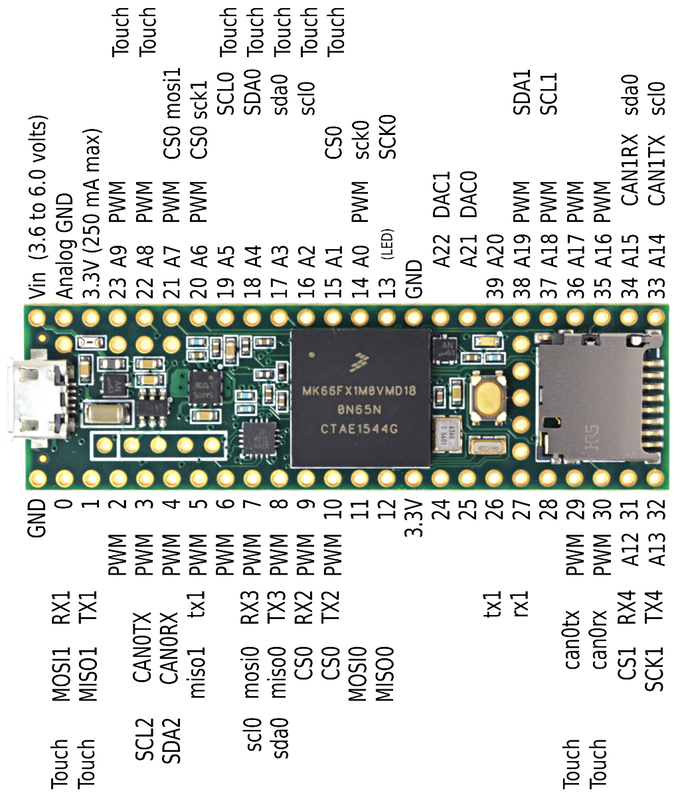Teensy 3.5 & 3.6: two new versions of Arduino-compatible boards

Teensy is a whole family of small boards that are compatible with the Arduino IDE. Older members of the family (version 3.x) are based on high-performance ARM processors with the Cortex-M4 core. These boards are always productive, equipped with a large amount of memory and a sufficient set of interfaces for practically any tasks.
Now there are two new models of the family - Teensy 3.5 & 3.6. It took the authors about a year to develop them. Major changes - the use of more powerful than in previous versions of chips. These boards can be used both for training and for serious projects that require a large amount of memory, compatibility of everything with everything and high overall system performance.
Teensy 3.6 Features

- 180 MHz ARM Cortex-M4;
- 1M Flash, 256K RAM, 4K EEPROM;
- Microcontroller Chip MK66FX1M0VMD18 (PDF link);
- USB High Speed (480 Mbit / sec) Port;
- 2 CAN Bus Ports;
- 32 General Purpose DMA Channels;
- 11 Touch Sensing Inputs.
Teensy 3.5 specifications

- 120 MHz ARM Cortex-M4 with Floating Point Unit
- 512K Flash, 192K RAM, 4K EEPROM
- Microcontroller Chip MK64FX512VMD12 (PDF link)
- 1 CAN Bus Port
- 16 General Purpose DMA Channels
- 5 Volt Tolerance On All Digital I / O Pins
The above shows the characteristics that are different. The total of the boards is as follows:
- 62 I / O Pins (42 breadboard friendly)
- 25 Analog Inputs to 2 ADCs with 13 bits resolution
- 2 Analog Outputs (DACs) with 12 bit resolution
- 20 PWM Outputs
- USB Full Speed (12 Mbit / sec) Port
- Ethernet mac, capable of full 100 Mbit / sec speed
- Native (4 bit SDIO) micro SD card port
- I2S Audio Port, 4 Channel Digital Audio Input & Output
- 14 Hardware Timers
- Cryptographic Acceleration Unit
- Random number generator
- CRC Computation Unit
- 6 Serial Ports (2 with FIFO & Fast Baud Rates)
- 3 SPI Ports (1 with FIFO)
- 4 I2C Ports
- Real time clock
')
Pinout board

Teensy 3.6 has a second USB port that is capable of transferring data at 480 Mbps. You can connect ordinary peripheral devices to it, like a keyboard or a flash drive.
The Arduino IDE is used for programming the board. The author claims that the boards support almost all Arduino functions, and also use widely used libraries. According to the developer, Teensy is a great way to get started with ARM. When meeting with the board, the user starts programming in the Arduino IDE using the simplest libraries. After that, you can try to write code for ARM, and in the same environment. And after getting some experience, you can start working in development environments such as Keil or IAR.
To start, start working in the Arduino IDE, you need to run the installer , which will add a new platform.

In a general sense, Teensy boards have everything you need to work. This is more than just a fee. On the basis of Teensy you can create the most complex projects that you can imagine.
Now the author has launched a fundraising campaign on the version of Teensy 3.5 & 3.6, and the money raised has been much more than originally planned. At the time of this writing, $ 100,194 was raised instead of $ 5,000. Teensy 3.5's early "depositors" cost just $ 23, and Teensy 3.6 costs $ 28.
Shipment of the first boards will begin in October 2016.
Invitation to test dadzhetov
The djet invites authors interested in testing our devices ( we don’t have Teensy , our own devices are offered for testing ) and write an objective review, for cooperation. The device after the publication of the review remains with you. Read more about the offer here .
Source: https://habr.com/ru/post/397097/
All Articles